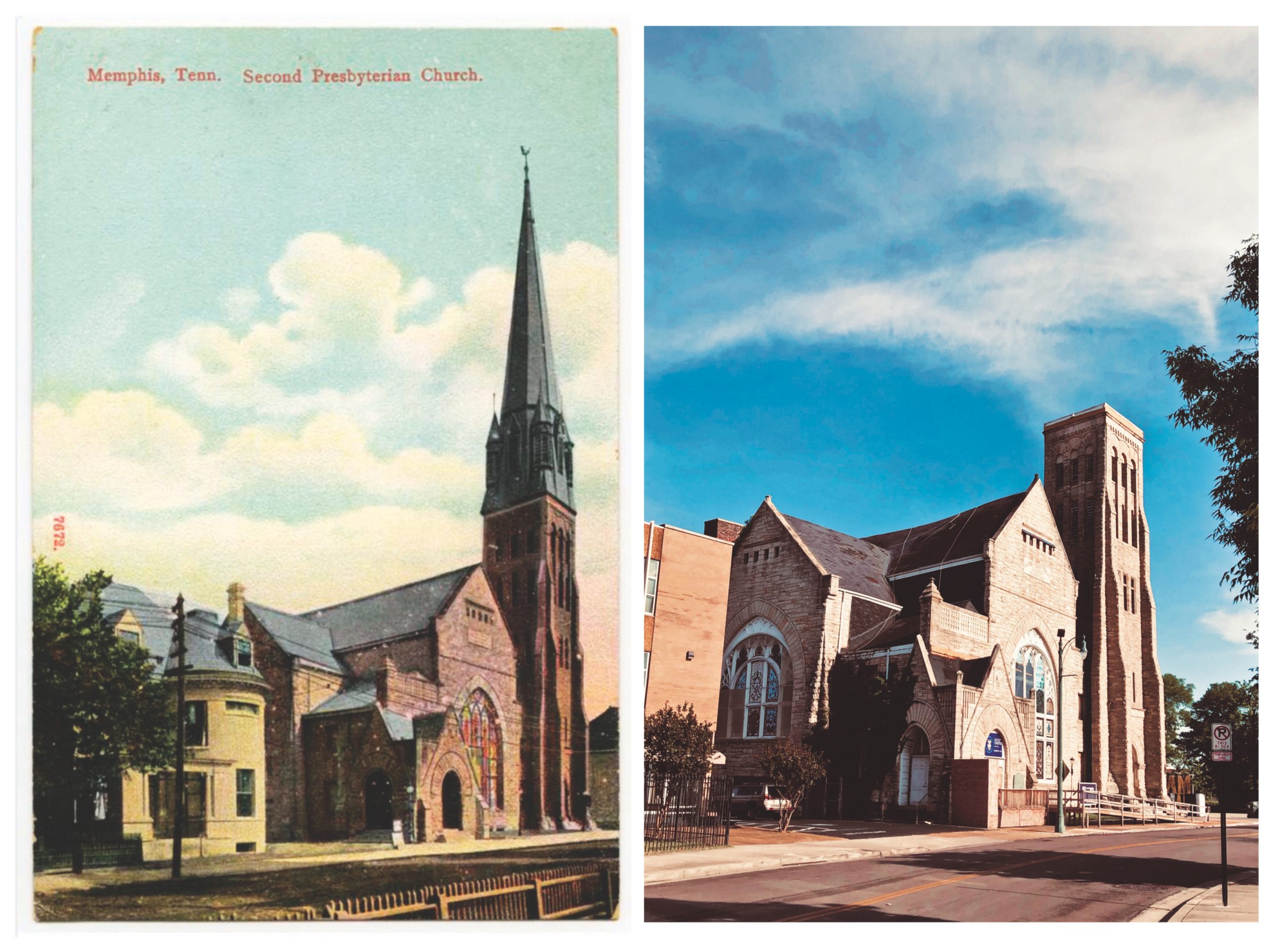Profile #4 in StoryBoard’s look at progress in historic preservation over the last decade
HISTORIC PRESERVATION
By Charlie Lambert
In 2015, the historic and deteriorating Clayborn Temple was purchased for $65,000, almost half the cost for the land and the construction of the church over 130 years ago. But millions of dollars more would be needed to bring it completely back to life.
In 1887 the congregation of the Second Presbyterian Church purchased a plot of land at the corner of Hernando and Pontotoc in downtown Memphis. They paid $14,000 for the plot and spent $100,000 building the large church which would one day be called the Clayborn Temple. In fact, by the time of its dedication, the Second Presbyterian Church was the largest church built south of the Ohio River.

Right: the church at the corner of Hernando & Pontotoc, c. 1900. Postcard (uncredited) from a J.C. Coovert photo.
* * * * *
The cornerstone was laid in 1891 and it was dedicated in 1893. The Presbyterians worshipped in the church until 1949 when they moved away from downtown and sold the building and grounds to the African Methodist Episcopal (AME) congregation for $100,000, exactly what it cost to build the church in the 19th century.
The new owners changed the name of the church to the Clayborn Temple after an AME bishop. They worshipped there for almost forty years through the 1980s before that congregation, too, moved east.
In the interim, the church was home base for many Civil Rights activities in the 1960’s. During the historic Sanitation Strike of 1968, the Clayborn was headquarters for the marches and is where the I AM A MAN signs were distributed.

* * * * *
After that important era, the backhoes of urban renewal ravaged the surrounding neighborhood, and in the wake of the killing of Dr. Martin Luther King, Jr. and the emptying out of Downtown Memphis, the building fell into disrepair and suffered the woes of age and deterioration. The roof nearly collapsed and the interior rotted. Even the many beautiful stained-glass windows were boarded up to protect them.
In the mid-1970s the Clayborn Temple Restoration Coalition was created, consisting of the AME congregation, Memphis Heritage and other interested groups and individuals, to formulate plans for the restoration of the church. In 1979 the Tennessee Historical Commission successfully added the temple to the National Register of Historic Places. But even that distinction and the coalition could not guarantee its survival. It shut its doors in 1999.

Finally in 2015, the nonprofit Neighborhood Preservation Inc. (NPI), under the leadership of NPI President Steve Barlow, purchased the deteriorating structure from the AME church for $65,000 and began raising additional funds for restoration and sought out a team to lead a restoration effort. And in 2016 Frank Smith and Rob Thompson began a successful effort, called “CLAYBORN REBORN,” to totally refurbish the building. Montgomery-Martin Construction Company was hired to oversee and affect its return to a viable condition, and in early 2019 Anasa Troutman was named executive director of the project.
“When I go out there, I see beauty,” said Troutman to StoryBoard‘s Margot Payne in April, 2019 (full story here). “I don’t see decay. I think that it’s a metaphor for our city and for our country. Even in our brokenness we can find beauty and a reason to keep going, find something to build on.”
Clayborn Temple has been named to the new multi-state U.S. Civil Rights trail, along with the Lorraine Motel and Mason Temple, and it will be a stop on the planned Memphis Heritage Trail of civil rights sites. In early 2019 it was announced that a building permit was being sought amounting to $1.5 million, to begin work on the building’s exterior.
~Memphis Heritage preservation page for the Clayborn.
In 2017 the National Trust for Historic Preservation named Clayborn Temple a “National Treasure.” Today, the Clayborn is in the middle of a complete restoration, preparing to host concerts, meetings, and other community events on a regular basis. Its future is, hopefully, going to be as grand as its past. <>
This is fourth profile in our series on progress in historic preservation over the last decade. To read more in this series, please visit the main article here.


It is a real shame that no trace of the entire sanctuary’s multitude of curved pews and many original gas/electric light fixtures have disappeared which were still there in the 1970s and were last seen during the time of its last tenant in 1999. Last time I visited, right after MLK 50, I even had to point out to my guide the difference between the gas and electric portions of the great central light fixture which I remembered from the 1970s when even some of the glass portions still remained. Wasn’t there an urban legend that the Christ figure leaving the window signaled the end of the world?
Hey Vincent! Nice to hear from you. I am not sure about gas/electric fixtures, and have not heard about that urban legend. I’m sure many people were in and out of the structure between ’99 and 2015. Perhaps you can find some evidence from this site? … https://www.artofabandonment.com/2014/10/clayborn-temple-memphis-tn/ and
I have a curved pew that supposedly came from Claymore Church